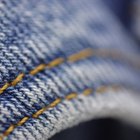
Medioimages/Photodisc/Photodisc/Getty Images
In 1873 Levi Strauss and Jacob Davis were granted a U.S. patent for the invention of blue jeans. These jeans, more commonly known as Levi's, were first used as men's work pants, but have since become a fashion wear for both men and women. The trademark of Levi's jeans is the double arch stitching pattern, also called the “arcuate,” located on the back pocket. If you want to remove this stitching pattern, use a seam ripper.
Hold the Levi's on your lap with the pocket side up.
Place the seam ripper between the fabric and the thread that forms the stitching. The sewing may be very tight and getting the seam ripper between the fabric and thread can be difficult. Be careful not to push the seam ripper through the fabric.
Pull the seam ripper upward to break the thread.
Place the seam ripper between the fabric and thread next to the spot you just broke and begin pulling the thread out of the fabric. The thread may come out intact or in pieces.
Continue pulling the thread out until you remove the entire double arch stitching.
Related Articles

How to Repair a Ripped Back Pocket on ...

How to Remove Studs & Rivets From Jeans

How to Lengthen Dress Coat Sleeves

How to Get Skinny Jeans to Be Less Tight

How to Put a Zipper on a Jacket

How to Get a Worn Look on the Bottom of ...

How to Glue Rhinestones on Jeans

How to Press Jeans

How to Shrink Denim Jeans

How to Stretch Out Cutoffs

How to Tuck & Tape

How to Replace Pearl Caps on Snap ...

How to Get Pills out of Jeans

How to Put on Suspenders

How to Fade & Distress My Jeans

How to Remove Pierced Earrings From ...

How to Replace Lace Grommets in Boots

How to Loosen the Thighs of Tight Jeans

How to Fix a Wire That Has Come Out of ...

How to Sew slippers
Writer Bio
Maria Hoven is a health and fitness expert with over 10 years of expertise in medical research. She began writing professionally in 2004 and has written for several websites including Wound Care Centers and healthnews.org. Hoven is earning a Doctor of Philosophy in cell and molecular biology from the University of Nevada, Reno.
Photo Credits
Medioimages/Photodisc/Photodisc/Getty Images